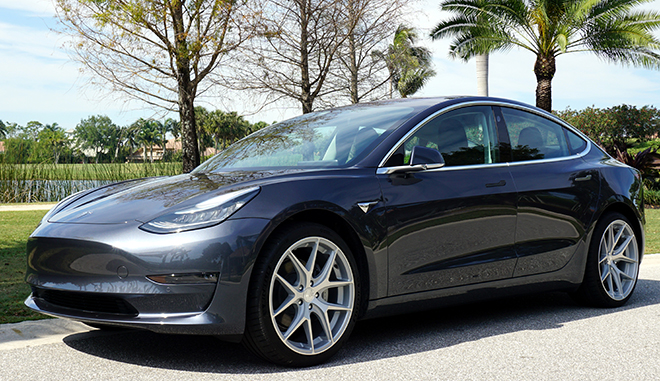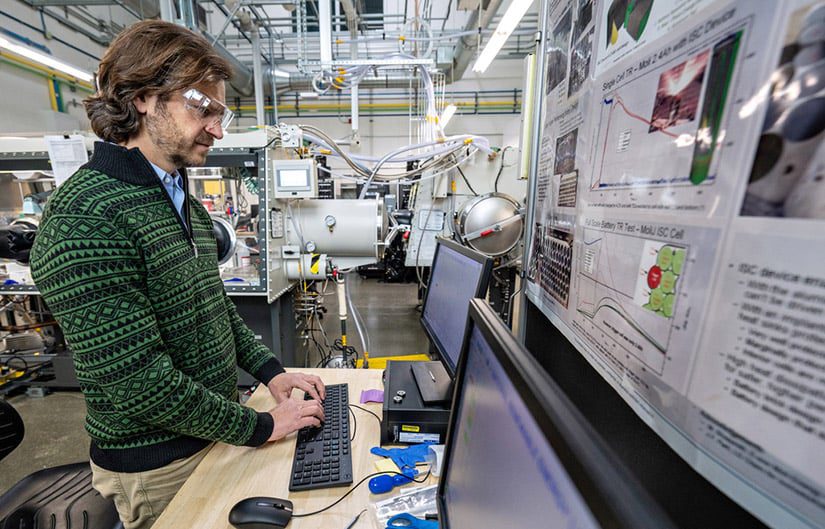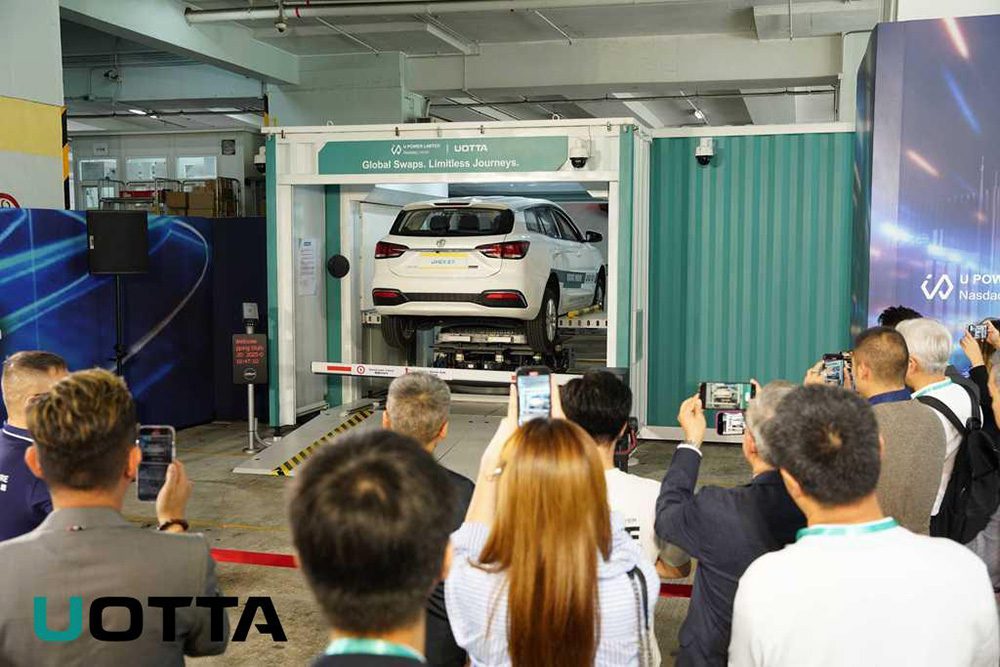Tesla’s Model 3 is breaking new ground in all kinds of ways. I’m pretty sure no new vehicle in history has ever been so difficult for members of the news media to get hold of. Unlike other automakers, Tesla provides very few review vehicles to the press – even the handful of favored media outlets have had to settle for brief test drives. CNN actually had to rent a Model 3 on Turo in order to do a review!
Fortunately, our colleagues at Tesla aftermarket supplier EVannex were among the first non-Tesla employees to receive a Model 3 – probably thanks to the fact that founder Roger Pressman was the owner of a Signature Series Model S – and I recently got to take it for a spin through the sprawl of suburban South Florida.
My big-screen debut
First I received the grand tour, which for Model 3 mostly means stepping through pages on the touchscreen display. This screen controls most of the car’s functions, and it has been the focal point of most media reviews: some love it, some hate it, most agree that it “takes some getting used to.” However, I don’t find Tesla’s new minimalism to be that radical a change.
Much has been made of Model 3’s comparative lack of physical knobs and switches, but in fact, the controls you need to use while driving – gear selector, turn signals – are right where you’d expect to find them (on two steering wheel stalks), and so is the volume control for your tunes (one of two trackballs on the steering wheel controls the sound system, and the other controls whatever you’re looking at on the screen). Doors and windows are opened in the usual fashion.

Your nav system, phone, stereo, and system settings (you can choose from 3 steering modes, 2 regen modes, creep/no creep, etc) are all controlled onscreen – but that’s nothing radically new. Cars’ background functions have been migrating to screens for over a decade, especially on higher-end models – even my 2006 Prius has a touchscreen (albeit a far more primitive one). Headlights went automatic a generation ago. The only things that arguably seem a bit weird to operate from the screen are the windshield wiper speed (Tesla is said to be working on that one) and opening the glovebox (and there may be a specific reason for that).
So yeah, the 3’s user interface would be revolutionary compared to a car from the 1980s, but to me it just seems like an elegant execution of a natural progression (which could have described the iPhone when it came out). Tachometers, odometers, temperature and oil pressure gauges and other dashboard doodads are really just steampunk-style vestiges of a long-gone automotive age. The only thing you need to see when driving is the speedometer and the nav screen, and glancing to the right instead of glancing down is a minor adjustment.
I say it’s high time somebody cleared away all that clutter. Model 3’s interior is a modernist masterpiece of minimalism. Instead of looking at a jumble of AC vent controls, your eyes rest on an attractive piece of (supposedly real) wood trim running the width of the dashboard. It may just be that this simpler, less busy line of sight, combined with the silence of electric drive, makes for a more relaxed driving experience.

Yes, of course it drives great
I’ve never claimed to be an expert on handling, but even I could appreciate Model 3’s rock-solid cornering – even at moderately high speed, it takes the curves as if it were fastened firmly to the road. My car guy friends at EVannex told me that the suspension is somewhat stiff (in a good way), comparable to a BMW 3 Series, whereas Model S, especially with the optional air suspension, delivers a smoother ride, more typical of a luxury car.
I also had the opportunity to drive Matt Pressman’s Signature Series Model S, to compare its ride with that of Roger’s Model 3. Both have acceleration to spare, and both handle wonderfully, but there’s definitely a difference. Again, I can’t describe it in technical terms, but you can feel the difference in size (Model 3 is a foot shorter and a thousand pounds lighter). The S drives like the bigger, heavier car it is, while the 3 feels nimbler – “like a water bug,” as Roger put it.
You engage Autopilot by pushing the gear selector all the way down – one tap for cruise control, two taps for full Autosteer. I only had a short time to experience Autopilot on the highway, so I can’t really say how it compares to the version in Tesla’s older vehicles. However, the Pressmans have all three generations of Autopilot represented in their fleet – their Model S has none, the X has first-gen AP, and the new 3 has the latest and greatest, Autopilot 2, which Roger says seems generally equivalent to the older version. As others have, he noted that it’s particularly handy in stop-and-go freeway traffic (all too common in the Miami/Broward agglomeration), freeing you of the tedium of maintaining a constant distance.
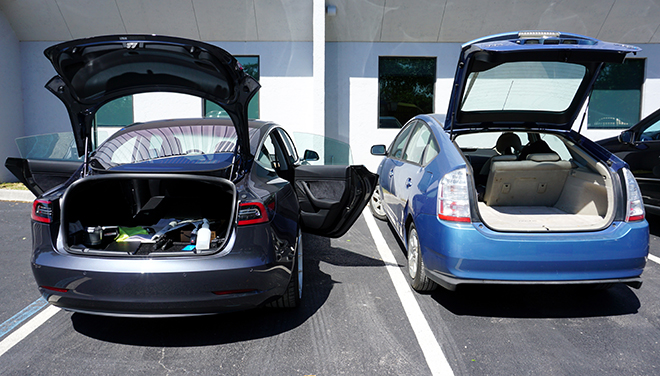
Is it the new Bluesmobile or what?
One aspect of autos in which I can claim some expertise is storage space. As a working musician, I lift large, heavy objects in and out of my vehicle on a daily basis and, as I’ve written many times before, it isn’t all about the cubic feet – the ideal gear-hauler has a wide opening, a low deck with seats that fold flat, and little or no “lift-over” at the back. I was keen to check out Model 3’s trunk for myself, and to compare it with the S and my trusty if unglamorous Prius.
When it comes to width, Model 3 makes the grade – I’d have no problem getting a medium-large guitar amp in there. Unfortunately, the 3 has a bit more of a lift-over than the S, and the rear seats don’t fold quite flat. It’s probably possible to get your PA system, milk crates and guitars in there, but it would call for some creative packing, and you’d have to be careful not to bash up the interior fixtures. The verdict: Model 3’s cargo capacity will be quite sufficient for the average driver, but for those of us with special needs, it can’t compare to Model S (and – sorry, folks – the lowly Prius remains the king of small cargo-carrying cars).
All this really shouldn’t be read as a criticism. No one ever said Model 3 was a hatchback – it’s a sedan, and sedans are designed for hauling people, and maybe a few bags of groceries. Model 3’s cargo-carrying capabilities may be inferior to those of the marvelous Model S, but they’re far superior to those of legacy mid-size sedans.
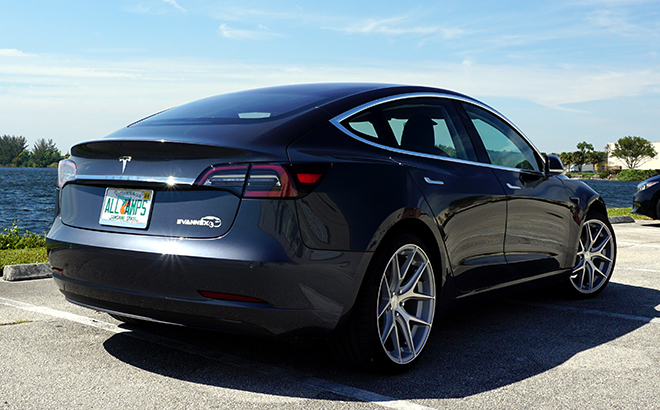
Just one little problem
Having experienced Model 3, I’m convinced that, once the word gets out, everybody is going to want one. Alas, most will not be able to get one. I have faith that Tesla will eventually reach its aspirational production rate of hundreds of thousands per year, but even so, there will surely be a waiting list for the foreseeable future.
As Tesla struggles through “production hell,” many superficial observers believe that legacy automakers will step into the breach, mass-producing their own EVs and burying the plucky little startup. However, as I argue in the upcoming issue of Charged, it’s becoming apparent that EVs aren’t going to be much of a money-maker for the majors. When battery costs pass that magical $100/kWh milestone, as will happen within the next couple of years, demand for EVs will swell, and carmakers will face a dilemma: crank up the production lines and cannibalize their golden geese, or continue trying to hold back the electric tide, and risk being Kodaked (there’s also a major risk of mixed metaphors and neologisms).
Ironically, after years of writing “Nobody’s buying EVs” stories, the mass media could soon be churning out “Nobody can buy an EV” articles.







